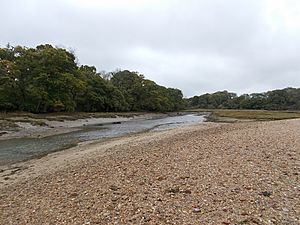King's Quay, Isle of Wight facts for kids
| Site of Special Scientific Interest | |
 |
|
| Area of Search | Isle of Wight |
|---|---|
| Grid reference | SZ536935 |
| Interest | Biological and Geological |
| Area | 97.2 hectare |
| Notification | 1951 |
| Location map | Natural England |
King's Quay is a fascinating place located on the northeast coast of the Isle of Wight. This island is just off the South Coast of England. King's Quay includes the mouth of a small stream called Palmer's Brook. You can find it between East Cowes and Wootton Creek, about 2 kilometers (1.2 miles) northwest of Wootton.
This area is private land and part of the large Barton Estate. It's also recognized as a very important natural site. It is a Site of Special Scientific Interest (SSSI) and a Ramsar site. This means it's protected because of its unique wildlife and geology.
Contents
Discover King's Quay Shore
King's Quay is a special natural area on the Isle of Wight. It's known for its beautiful landscapes and important history. This place is home to many different plants and animals. It also holds clues about Earth's past, like ancient fossils.
What Makes King's Quay Special?
King's Quay is a mix of different natural habitats. You'll find areas of saltmarsh, sandy shores, and marshland. These areas are surrounded by very old woodlands. These woods include Wallhill Copse, Curlew Copse, Woodhouse Copse, and Brickhill Copse.
The "Quay" itself is a raised path or causeway. It has a break in one spot, where a stone bridge crosses over. This unique landscape makes King's Quay a valuable place for nature and history.
A Special Place for Nature
King's Quay is protected because it's so important for nature. As a Site of Special Scientific Interest (SSSI), it means the area has rare plants, animals, or geological features. Being a Ramsar site means it's an internationally important wetland. Wetlands are vital for many bird species and other wildlife.
Fossils and Ancient Tools
This area is incredibly rich in fossils. Scientists have found many fossils of fish from the Oligocene period here. This period was millions of years ago! There are also Mesolithic artifacts. These are tools and objects made by humans from the Middle Stone Age. You can find these ancient treasures in a rocky area known as the Osborne Beds.
A Haven for Wildlife
The mix of saltmarsh, sand, marsh, and ancient woodlands creates a perfect home for many creatures. Birds, insects, and unique plants thrive in these different environments. It's a great example of how different habitats can work together to support a wide variety of life.
History and Legends
King's Quay has a rich history, including some interesting stories and legends.
The Story of King John
There's a famous story about King John and King's Quay. Legend says that King John fled to this spot after signing the Magna Carta. The Magna Carta was a very important document that limited the power of the king. While this story is probably not true, it's how the place got its name.
Pirates and Markets
During the Middle Ages, King's Quay and a nearby spot called Meads Hole had a secret market. This market was where pirates from the Isle of Wight would sell goods they had taken from French and Spanish ships. It was a bustling, if unofficial, trading spot in those times!
Exploring the Area
King's Quay is mostly private land. This means it's not open to the public for general access. However, you can get close to it from the southwestern end. This access point is through Forestry Commission land at Woodhouse Copse. It's a great way to see some of the beautiful woodlands that surround King's Quay.

